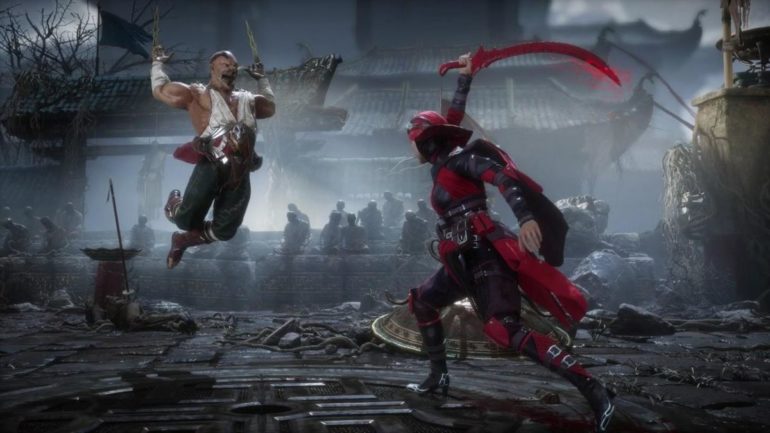Is it April 23rd yet? After getting some hands-on with Mortal Kombat 11, I’m even more excited for the game’s full release date. These next three weeks better fly by otherwise I might liable to uppercut somebody’s head off out of impatience, and unlike Johnny Cage, I’ll be able to nail it on the first take.
We’ve already spoken about how Mortal Kombat 11’s Custom Variations system could be it’s best feature so far, but as for the gameplay itself, MK 11 introduces a few new changes to the traditional formula that could make Mortal Kombat 11 a big hit for casual and hardcore players alike. These changes prove that Mortal Kombat is a series that isn’t afraid of reinventing itself.
At a base level, MK 11 doesn’t seem to dissimilar to MK X and the 2011 series reboot before it. X and Y are for punches while A and B are for kicks and the right trigger is the block button. It’s still weird that Mortal Kombat has a block button, especially as a 2D fighter, and I’ve eaten more than enough hits forgetting about that, but that’s neither here nor there.

On a more advanced level, MK 11 promotes better space control via footsies and mind games over having the biggest combos, which is great news for anybody who struggles with combos beyond a character’s basic 3-hit chain followed by a special move. Big combos still have their place, and we’ll get to that, but if you’re able to keep your opponent guessing, you’ll have more success than someone who managed to workshop some elaborate 15 hit combo that only has one set-up.
Each character has a set amount of specific combo strings and special moves, and these special moves can be amplified with a press of RB. Depending on the move, amplifying it can offer increased damage, better combo potential or other gimmicks, and with the changes to Mortal Kombat’s meter system, amplifications are much more prevalent than ever.
In most 2D fighting games, players fill a special move meter during the fight that allows them to boost attacks at a cost or give them new defensive options. When completely filled, it grants access to a powerful super move, but Mortal Kombat 11 isn’t like most fighting games, and it’s all the better for it.

Players now have two meters, one offensive and one defensive, with the offensive meter amplifying attacks and the defensive meters being used for powerful wake up attacks or breakaways that allow you to better escape combos. Both these meters refill naturally like a cooldown, so you don’t have to worry about beating on your opponent, or getting battered by them, to build that meter. You’re always pretty close to your best tools.
Instead of cashing in a full meter for an X-Ray attack like previous Mortal Kombat games, there’s the new Fatal Blow mechanic that takes its place. Once you’re below thirty percent health, pressing both triggers together activates a Fatal Blow, a cinematic super move that isn’t quite as fatal a blow as those fatalities. Semantics, eh?
As they’re only available once you’re at low health, Fatal Blows make for the perfect comeback mechanic, specifically because they delete about a third of the opponent’s life bar if successfully hit. Whiffing the attack will trigger a small cooldown timer, but essentially you have an infinite amount of tries to land the attack while in range.

The kicker is that once you’ve landed a Fatal Blow, that’s your lot. It’s a one-time use, meaning there’s an added layer of strategy that goes into when to use your biggest weapon. Throwing out your Fatal Blow halfway into the first round might cost you the match in the long run. Conversely, if your opponent keeps trying to use it when you’re comfortably ahead, the sound strategy could be to just take the hit, robbing your foe of a tool later on in the match.
Those lamenting the loss of those brutal X-Rays will find some solace in the introduction of Crushing Blows, which offer the same bone-crunching satisfaction. Certain moves or combos in a character’s arsenal can trigger Crushing Blows, such as uppercutting an opponent who’s attacking high, which will increase the damage of those moves and often allow for combo extensions, if you’re skilled enough for that at least.
Just like Fatal Blows, Crushing Blows can only be activated once per fight, but the amount of damage and combo potential they offer makes them game-changers. Skilled players will be able to link together Crushing Blows like punctuation in a sentence, creating a one-time use high damage combo, but again, their limited availability adds more strategy to MK 11’s metagame. That said, there will be moments where you accidentally trigger a Crushing Blow as the last move of a round, wasting it for the fight. Just accept that as part of the learning process.
Admittedly, using those previously mentioned defensive options, along with how to activate certain Crushing Blows and how they can extend combos wasn’t properly conveyed by the beta, but the full game will have a proper tutorial mode and a training mode, so hopefully things will be a lot easier to understand once the full game launches in a couple of weeks. Personally, I find it difficult to learn new combos mid-fight, so the beta was a trial by fire, resulting in a fair amount of batterings from more skilled players.
Despite that, Mortal Kombat 11’s closed beta proved that even though the franchise is getting on in years, NetherRealm Studios aren’t afraid to try and innovate with their flagship series. Turns out you can teach an old dog new tricks after all, creating a fighting game that feels familiar and fresh simultaneously.
Closed beta code provided by WB Games for the purposes of coverage.
Some of the coverage you find on Cultured Vultures contains affiliate links, which provide us with small commissions based on purchases made from visiting our site.

